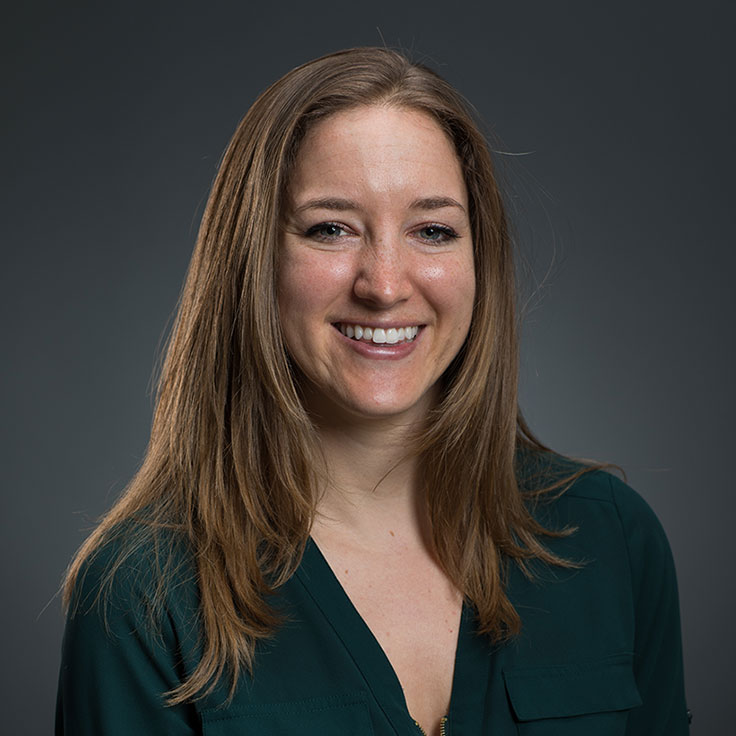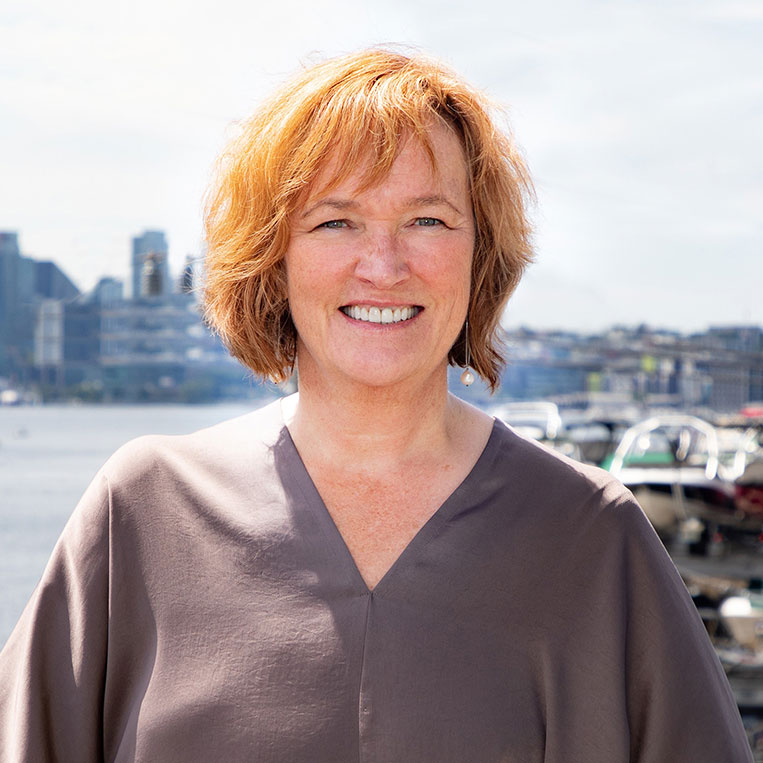Engineering health care for the brain, from infancy to late adulthood
Injury or disease in our most complex organ, the human brain, can be hard to detect and even harder to treat. Advancing technologies for brain health requires interdisciplinary collaboration from clinicians and engineers in fields that range from data science to medicine. At the 2022 Engineering Lecture Series, we highlighted research with potential to transform brain therapeutics from infancy to late adulthood.
Engineering therapies for the pediatric brain
Elizabeth Nance, Jagjeet and Janice Bindra Endowed Career Development Associate Professor of Chemical Engineering

Children make up 27% of the world's population, but most therapeutics for brain disease are tested on adults with pediatric clinical trials often following years later. This has led to a significant gap in medical technology for infants and children. UW chemical engineering associate professor Elizabeth Nance is developing therapeutics for newborn and pediatric brain disease, with the goal of improving neurological function and quality of life. Learn more about Nance’s work to expand brain health options through these early stages of life.
Elizabeth Nance is the Jagjeet and Janice Bindra Endowed Career Development Associate Professor of Chemical Engineering, with appointments in bioengineering and radiology, and affiliate memberships with the eScience Institute, Molecular Engineering & Sciences Institute, and Center on Human Development and Disability. Nance’s research focuses on understanding the brain’s response to injury or disease and developing nanotherapeutic platforms to treat brain disease, using nanotechnology, neurobiology, and data science tools.
From discovery to design: Toward early detection and treatment of Alzheimer’s disease
Valerie Daggett, David and Nancy Auth Endowed Professor in Bioengineering

More than 5 million Americans are living with Alzheimer’s disease — a number projected to rise to 14 million by 2050 — and currently, there is no cure. UW bioengineering professor Valerie Daggett has been studying misfolded amyloid proteins that cause diseases like Alzheimer’s, as well as Parkinson’s and others, since the 1990s. This work has been spun out to form a company with a promising platform for early diagnosis and treatment of Alzheimer’s. Hear from Daggett about the technology and collaborations driving this groundbreaking work.
Valerie Daggett David and Nancy Auth Endowed Professor in Bioengineering and adjunct professor of biochemistry, chemical engineering and biomedical and health informatics at the University of Washington, as well as the founder and CEO of AltPep, a biomedical startup spun out from the Daggett Research Group. Daggett’s research uses computational and experimental methods to design diagnostic and therapeutic agents to target amyloid diseases, with active programs investigating protein dynamics and misfolding related to human mutations and various diseases.
Presented by the College of Engineering in 2022.
Past Engineering Lecture Series on YouTube
2020
Contact tracing: Fighting COVID-19 while respecting privacy
Stefano Tessaro (CSE)
2019
The Future of Food: Protecting Human and Environmental Health
Growing More with Less: Smart Tech Solutions to Feed the World »
Faisal Hossain (CEE)
Human and Ecosystem Health: Arsenic in Food, Water, Plants and Animals »
Rebecca Neumann (CEE)
Floods, Fish and People: Challenges and Opportunities in the Mekong River Basin »
Gordon Holtgrieve (College of the Environment)
2018
Engineering for Social Good: Assistive Robots, Environmental Equity and Disaster Relief
Building a Robot Butler: Towards Fluent Human Robot Interaction »
Siddhartha Srinivasa (CSE)
Clearing the Air: Environmental Justice and Air Quality »
Julian Marshall (CEE)
Meeting Our Global Obligations: The Hurricane Maria Energy & Health Project »
Lilo Pozzo (CE)
2017
Engineering the Data Revolution
Finding "Fake News" in Times of Crisis: Online Rumors, Conspiracy Theories and Disinformation »
Kate Starbird (HCDE)
Borrowing from Nature to Build Better Computers: DNA Data Storage and Beyond »
Luis Ceze (CSE)
Making Cities Smarter for Drivers: Using Data to Improve Urban Congestion and Parking »
Lillian Ratliff (EE)
2016
City Smarts: Engineering Resilient Communities
Engineering Solutions for a Seismically Resilient Seattle »
Jeffrey Berman (CEE)
Delivering Sustainability: Transporting Goods in Urban Spaces »
Anne Goodchild (CEE)
Understanding Our Chemical Fingerprints: Safer Water for Our Cities »
Edward Kolodziej (CEE)
2015
Robots to Web Trackers: Privacy in the Age of Smart Technology
The Invisible Trail: Pervasive Tracking in a Connected Age »
Franziska Roesner (CSE)
Our Robotic Future: Building Smart Robots that See in 3-D »
Dieter Fox (CSE, UW Robotics and State Estimation Lab)
Responsible Innovation: A Cross Disciplinary Lens on Privacy and Security Challenges »
Tadayoshi Kohno (CSE, UW Tech Policy Lab)
Ryan Calo (UW Tech Policy Lab)
Batya Friedman (UW Tech Policy Lab)
2014
Engineering the Heart: From Cell Therapy to Computer Technology
Engineering a Broken Heart »
Charles Murry (BioE, Pathology, Cardiology)
Get a Grip: Cell Biomechanics in Cardiovascular Health »
Nate Sniadecki (ME) and Nathan White (BioE)
Cutting the Cord: Wireless Power for Implantable Devices »
Joshua Smith (CSE, EE)
2013
Engineering Infrastructure: From Failing Grades to Future Systems
Failing Grades to Future Systems »
Paula Hammond (Parsons Brinckerhoff) and Greg Miller (CEE)
Spanning the Gap: Lessons in Bridge Engineering »
John Stanton (CEE)
Tunneling Toward a New State Route 99 Corridor »
Matthew Preedy, PE (BSCE '92)
2012
Engineering Molecules: Tiny Solutions for Big Problems
Launching the Molecular Engineering Revolution »
Matt O'Donnell (BioE)
Here Comes the Sun: Engineering New Solar Technologies at the Molecular Scale »
Hugh Hillhouse (ChemE) and Christine Luscombe (MSE)
Into the Body: Molecular Systems for Healing »
Suzie Pun (BioE) and Patrick Stayton (BioE)
2011
Re-engineering Aerospace: Flying Cleaner, Greener, Smarter
Shrinking the Aerospace Carbon Footprint »
Mary Armstrong (’79)
Repowering the Military with Alternative Energy »
Tim Vinopal (’91)
Flying Smart with Autonomous Vehicles »
Mehran Mesbahi (A&A)
2010
Engineering in the Headlines
High-Pressure Crisis in the Gulf »
James Riley and Alberto Aliseda (ME)
Going for the Green: London 2012 »
Robert G. Card (’75)
Driven to Distraction »
Linda Ng Boyle (ISE and CEE)
2009
Engineering Xtreme Challenges: Outerspace to Cyberspace
The Cyberspace Data Explosion: Boon or Black Hole? »
Magdalena Balazinska (CSE) and Tadayoshi Kohno (CSE)
Eye on the Universe: Final Mission to Hubble »
Gregory Johnson (’77).
Energy Crisis, Smart Solutions »
Carl Imhoff (PNNL) and Shwetak Patel (CSE and EE)
2008
Engineering Inspired by Nature: Robots, Greener Energy and Nanotech Systems
Where Humans and Robots Connect »
Yoky Matsuoka (CSE)
Back to Nature for the Next Technology Revolution »
Babak Parviz (EE)
Beyond Oil: Powering the Future »
Miles P. Drake (Weyerhaeuser) and Dan Schwartz (ChemE)
2007
Engineering the Best: Boomers, A Bridge and the Boeing 787
Rebuilding the Baby Boomer: Replacement Parts for the 21st Century »
Buddy Ratner (BioE, ChemE)
Building the New Tacoma Narrows Bridge »
Joe P. Mahoney (CEE) and Steve Hansen (’69)
Building the Future of Commercial Aviation: Boeing's 787 Dreamliner »
Al Miller ('71, '77) and Mark Tuttle (ME)